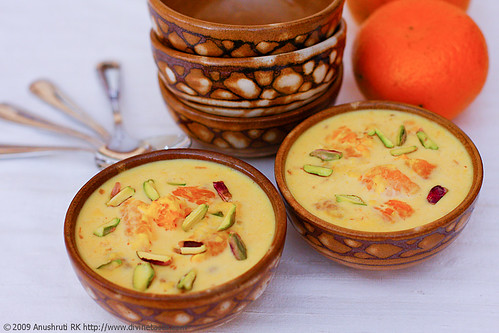Indian cuisine is greatly embraced across the world, because like Thai cuisine, the secret lies in the skillful use of spices. The southern part of India has a unique approach to food preparation with the predominant employment of rice and coconut. Fish is also a primary part of the diet in the coastal district, besides vegetarian.
Feast for your eyes!

(Chicken Tikka Masala)

(Phall)

(Biryani)

(Kheer)

(Samosa)
One of the most commonly used spices is garam masala. Other spices powders used are like turmeric, chili, cumin, coriander etc. The whole spices which bring unique flavor to Indian cuisine are like green cardamom, star anise, black pepper, cloves and cinnamon sticks etc.

Dining etiquette
As like in every country, there are rules to be observed during a meal. There is a special protocol in terms of mainly seven major factors like:
1.Seating style
2.Eating manners
3.Conversation
4.Food Habits
5.Food Talk
6.Dining Etiquette
According to the Indian customs and traditions cutleries are not employed, as the majority of the foods are best appreciated when ingesting with the hand.
1. Always sanitize hands before and after a meal.
2. Wait to be seated accordingly to seniority.
3. There is a practice of eating with right hand. Do not on any circumstance eat with left’ considered unclean.
4. The left hand is normally set on the table or your lap while ingesting.
5. Guests are often served in a meticulous sequence: the guest of Honour, men, and the children are the last to be waited on. Women serve everybody first and consume last.
6.Do not attempt to help yourself to food, always wait to be served.
7. Depending on the circumstances, sometimes food will either to served to you or you may be allowed to serve yourself from a common bowl.
8. Indians do not have a habit of sharing as it is considered unclean – do not offer to share.
9. Spoon is used for only liquid dishes, but apart from that, stick to hand.
In India, the general modus operandi is to graciously decline the first offer of beverage or snacks. You will be offered again. Turning down the first invitation is part of the code of behavior.
Eating with Indians is like an art, it is vital to observe these rules if you do not wish to pass off as insensitive and ignorant.
Music
India has a very established school of Music and Dance. Master performers are guided by an expert. Presentations could be appreciated by huge and enthusiastic viewers. Vibrant folk and tribal art forms also exist in parts of India but are increasingly fading away. Many government and non-government organizations are assisting in keeping these customary art forms animated. Indian music has essentially been known to be performed through three modes - vocal music, instrumental music, and dance. All the three mediums of music are prevalent in the two prominent kinds of Indian classical music, namely the North Indian classical music or the Hindustani classical music, and the classical music of South India or the Carnatic music, as well as other folk music.
The following is taken and adapted from http://www.indembkwt.org/culture.htm
Classical Music: The roots of the Indian music can be traced back to the Vedic period, when the celestial creator of the universe, Brahma was said to have handed down music to the world through his son, sage Narada, to usher in an era of peace and solace among humanity. The earliest form of music was used during the Vedic period as sacred hymns, which were chanted through a method called "Ek Swari Gaayana," meaning singing with the help of one note. The single note hymns gradually developed to the "Gatha Gaayana" method of singing with double notes. Eventually, the Vedic chants of the single note, double notes, and such other systems gave way to the initiation of the seven note system called "Saptaswara".
Hindustani Music : The history of Hindustani classical music is said to have originated during the period of the Indus Valley Civilization. After the decline of the Indus Valley Civilization came the stage of the Vedic music, in which sacrifices and prayers were made to the Gods through hymns and chants in musical style. Moreover, music was one of the key factors in the creation of two of the greatest of Indian epics, the Ramayana and the Mahabharata. Music in India, from the transitional period to the modern age has witnessed tremendous development in style and methodology.
Carnatic Music: The south Indian form of Indian classical music is known as Carnatic music, and is a musical style performed with the company of several musical instruments, such as violin, veena, mridangam, etc. Carnatic music is prevalent in the south Indian states of Tamil Nadu, kerala, Andhra pradesh and Karnataka. Carnatic music follows a pattern of mainly devotional themes, most of which are sung in the praise of Hindu deities. The prime components of Carnatic music follows the same pattern as any other Indian classical music, which are the Raga, implying the melody part, and the Tala, denoting the rhythmic part. Musical instruments are an intrinsic part of Carnatic music, and have strengthened the foundation of this art form at the hands of immaculate musicians like T.R. Mahalingam, M. Chandrasekaran, and so on. Some of the proponents of Carnatic classical music have created waves in the international circuit through their immortal compositions and have been bestowed with several awards and commemorations, thus making them legends in the field.
Art
Art pieces of Indian artist are assumed ‘marketetable’ in the art scene today. Contemporary Indian painters like MF Hussain, Ganesh Pyne and Anjolie Ela Menon are creating name for themselves in the international context. Indian literature is a treasure chest of wisdom and knowledge as well. From the antique sacred manuscript to current day writers are a long uninterrupted line of novelists who dexterously write down accounts of their tale sand remark upon modern-day life in India.

No comments:
Post a Comment